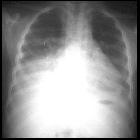bone marrow
Normal bone marrow is divided into red and yellow marrow, a distinction made on the grounds of how much fat it contains.
Gross anatomy
Red marrow is composed of:
- hematopoietic cells
- supporting stroma
- reticulum (phagocytes and undifferentiated progenitor cells)
- scattered fat cells
- a rich vascular supply
Conversely, yellow marrow has all the same constituents as red, except that fat cells make up the vast majority (80%, versus 40% in red marrow), with resulting poor vascularity. Distribution varies with age and from one individual to another but should be symmetric.
Normal marrow conversion
During infancy red marrow occupies the entire ossified skeleton except for epiphyses and apophyses. Gradually red marrow 'retreats' centrally, such that by 25 years of age it is essentially confined to the axial skeleton (pelvis, spine, shoulder girdle, skull). The conversion of red to yellow marrow begins peripherally (phalanges) before occurring in the femora/humeri. Within the long bones, the epiphysis is the first to undergo conversion followed by the diaphysis before extending to the metadiaphysis .
Also, islands of red marrow may be seen anywhere in the skeleton, typically in a subcortical distribution, often with central yellow marrow giving it a bull's eye appearance on axial imaging. Additionally, red marrow is found in subchondral crescents, typical locations include the proximal humerus and femur .
Yellow marrow can also be seen focally in vertebra around the basivertebral vein, adjacent to degenerative disc disease and Schmörl nodes, and within hemangiomas.
Several patterns of normal red and yellow bone marrow distribution in the spine have been described by Ricci.
Radiographic features
MRI
Signal characteristics of bone marrow include:
- T1:
- red marrow: hypointense to subcutaneous fat, but hyperintense to muscle and disc (due to scattered fat cells)
- yellow marrow: hyperintense (follows the signal of subcutaneous fat)
- T2:
- red marrow: slightly hyperintense to muscle, usually its signal intensity is slightly lower than that of yellow marrow, but sometimes it can be difficult to distinguish the two
- yellow marrow: hyperintense to muscle and iso- to slightly hypointense to subcutaneous fat
- STIR:
- red marrow: remains hyperintense
- yellow marrow: is saturated out (hypointense)
- T1 C+ (Gad): normal bone marrow in adults does not enhance visibly, whereas there may be a significant contrast enhancement in normal marrow of a neonate or a small child. Enhancement in adults occurs only in pathological marrow, which can be accentuated on post-contrast images with fat saturation
Related pathology
Broadly, marrow pathology can be divided into:
Marrow proliferation
Benign
- myelodysplastic syndrome
- polycythemia rubra vera
- myelofibrosis
- reconversion of yellow to red marrow
- mastocytosis
Malignant
- leukemia
- monoclonal gammopathies (plasma cell dyscrasias)
- multiple myeloma
- primary amyloidosis
- Waldenstrom macroglobulinemia
- lymphoproliferative disorder
- monoclonal gammopathy of unknown significance (MGUS) *
- monoclonal gammopathy of borderline significance *
Most of the above conditions (covered individually in the encyclopedic section) affect the marrow diffusely. The exception is multiple myeloma which has a predilection for focal deposits, and Waldenstrom macroglobulinemia which causes infarcts.
The MRI appearance is variable:
- normal red marrow appearance (10-25% of all leukemic patients will have normal appearing marrow)
- abnormal distribution of what appears to be normal red marrow
- abnormal signal from red marrow in a normal distribution
- abnormal signal and distribution
The abnormal signal is due to replacement of the small amounts of fat cells normally found in red marrow, such that T1 signal will decrease to or below the signal from disc or muscle. T2 signal is more variable, but will in general increase when compared to muscle.
Myelofibrosis and mastocytosis incite such prominent sclerosis that the marrow is very dark on both T1 and T2; a similar appearance to the marrow in hemosiderosis in patients with hemolysis from sickle cell disease and thalassemia.
The leukaemias typically affect the metaphyses > diaphyses > epiphyses. Changes in the latter indicate a large tumor load, and therefore has prognostic implications.
Yellow-to-red reconversion generates red marrow in an abnormal distribution. The marrow signal is, therefore, a very important aspect of correct image interpretation. It occurs in the reverse order to that of red to yellow conversion, and is seen in:
- sickle cell disease
- thalassemia
- hereditary spherocytosis
- athletes
- high altitude
- heavy smokers, especially obese women
Red marrow reconversion can be difficult to differentiate from metastases in the spine. In this regard, the T1 in- and out-of-phase sequences are helpful. If there is low focal signal on T1 in-phase, this may be due to either pathology. However, the scattered fat cells in red marrow cause marked signal loss on out-of-phase images. There is no such signal loss in metastases.
Siehe auch:
- Hämangiom
- Osteomyelofibrose
- Sichelzellenanämie
- Multiples Myelom
- Amyloidose
- Thalassämie
- Hämosiderose
- Mastozytose
- Knochenmarksveränderungen nach Bestrahlung
- Waldenström's macroglobulinaemia
und weiter:

 Assoziationen und Differentialdiagnosen zu Knochenmark:
Assoziationen und Differentialdiagnosen zu Knochenmark:






